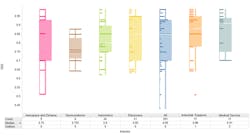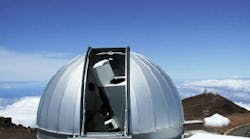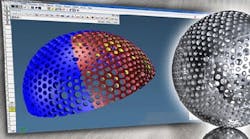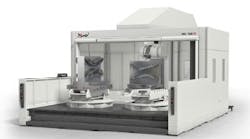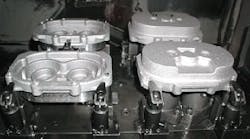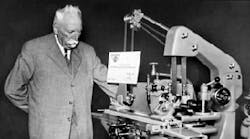Manufacturing equipment OEMs want to help their customers save energy. And the best way those OEMs know to accomplish that is through innovative design features and systems. Some of these include spindles that return energy, step sleep modes, low-heat motors, and regulator systems for air gaging.
The spindle on Methods Machine Tools Inc’s heavy-duty Fanuc RoboDrill Ft14Fe vertical machining center, for example, is one that returns energy to the machine in the intervals between cutting. The spindle runs at 14.75 hp (peak) at 10,000 rpm. It’s a direct-drive type with precision-enhancing thermal compensation and HRV control.
To conserve energy, the MAG Specht 500/630 horizontal machining center eliminates machine warm-up time, sleeps when idle, incorporates regenerative drives and uses half the normal coolant requirements. The machine also offers minimum quantity lubrication (MQL) operation.
MQL is a nearly dry machining process that uses a through-tool oil mist tailored to provide just the right volume for ideal lubricity at the tool-and-worksurface interface. MQL eliminates the need for chip flushing coolant and the associated energy costs for pumps, filter media and chip drying.
Motors are typically at the forefront of many OEM energyconserving efforts. The reason is that motors create heat, and that heat must be kept in check through cooling systems that add to energy consumption.
To eliminate the need for extra cooling systems on its EDMs, AgieCharmilles uses compact, low-heat motors to eliminate the need for cooling machine drive systems. The company also incorporates other energysaving components geared specifically to EDMs.
For example, generators on AgieCharmilles EDMs consume fewer Kw per hour for a savings of up to $6,000 annually. In addition, the company’s pallet-type machine platforms are smaller in size, which reduces necessary airconditioning requirements.
Probably nowhere else is motor heat more of a concern than with CNC multispindle machines. Imagine having to deal with the amount of heat generated by six or eight motors powering six or eight spindles. This is the situation that machine tool builder Tajmac-ZPS was up against when designing its line of Mori-Say TMZ CNC multispindle machines.
On typical multispindle machines, spindles and their drive motors are both located within the machine’s spindle drum, thus creating the need to cool the drum and consume more energy. Tajmac-ZPS, through an innovative design, eliminated having to cool its machine drums.
The company’s design re-locates all spindle drive motors away from the machine’s drum. Drive motors reside at the machine end opposite the end housing the spindle drum. Plus, the design requires less-power-consuming motors.
Air gages can be a big consumer of energy. For approximately 90 percent of the time, these systems are not in use, and they function on clean, dry compressed air in a highly controlled flow that takes energy to produce.
However, according to Stotz USA LLC, a manufacturer of air-gaging equipment, it would be impractical and inefficient to turn the units off when not in use, as doing so would require an extended period of time to restart, balance and stabilize the measurement to achieve the desired accuracies.
Fortunately, a digital I/O regulator switch can be connected to the air column to turn down the airflow when the unit is not in use. The switch restricts airflow by as much as 90 percent, but still flows at a consistent and measured level. This guarantees that the measurements taken when the air returns to full flow are accurate and repeatable.
If compressors aren’t running to produce unused airflow, the savings are quite substantial. On average, according to Stotz USA, a 40 percent or better savings in direct energy costs per compressor would not be an unreasonable expectation.




